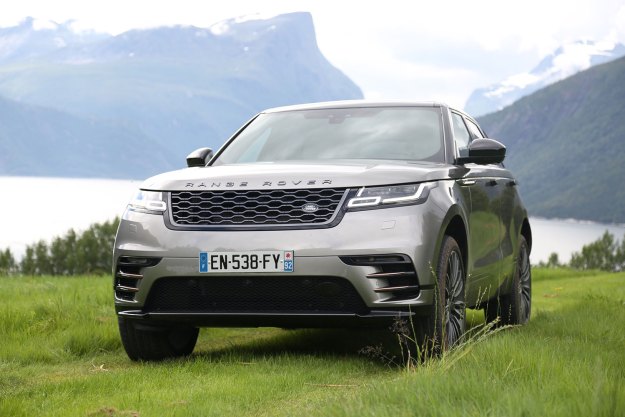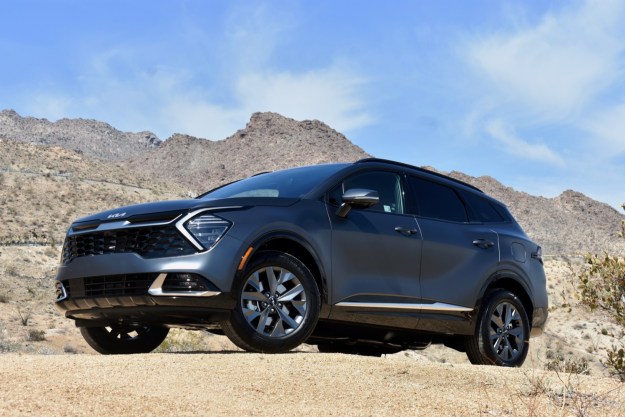
“The Velar is a beauty on road and a beast off it.”
- Immense off-road capability
- Dashing exterior design
- Tranquil cabin
- Innovative interior gadgets
- Steep learning curve for tech
For 34 years, the Range Rover moniker represented a single, full-size Land Rover vehicle with renowned off-road grit. With the arrival of the Sport (2004) and Evoque (2011), Range Rover came to represent more than just all-terrain capability. Style, performance, and luxury were the new buzzwords surrounding Land Rover’s iconic nameplate. Given the posh trajectory, one might assume we’d be more prepared for the fourth member of the family, but after our Land Rover Range Rover Velar first drive review, we discovered that we simply weren’t.
The Velar is unlike any Land Rover product ever seen in concept or production husk. The SUV’s striking exterior, minimalist cabin, and innovative gadgetry tear open the envelope that once contained our expectations.
Even the name echoes the new model’s significance. Derived from the Latin word “Velaris,” meaning “hidden” or “disguised,” Velar first appeared on early Range Rover prototypes during the late 1960s. Decades later, Land Rover is once again making an important statement, and anyone who wasn’t listening then had better listen now.
What’s new
The Velar name may be steeped in Land Rover history, but everything else about this premium SUV is all-new. From the aluminum-intensive platform, to the cockpit’s three TFT screens, to the curvaceous sheet metal, the 2018 Range Rover Velar is an intersection of “firsts” for the U.K.-based manufacturer.
Trim levels & features
Land Rover’s lowest, most aerodynamic model ever, the Velar slips through the air with a drag coefficient of just 0.32Cd. Motionless, its sleek panels appear pinned to the frame like a greaser’s hair to his scalp — right down to the flush door handles that emerge only when summoned. Cues from both the redesigned Discovery and Evoque grace the Velar’s design, though its overall aesthetic is rousing like no Land Rover before.
A high, defined beltline, cab-rearward proportions, a long wheelbase, and an elegantly sloping roofline distinguish the Velar’s silhouette. In profile, blackened pillars visually separate the greenhouse from the SUV’s body. Viewed from above, its recessed cabin traces an unbroken circumference akin to a layer cake. At the front, a rounded fascia is contrasted by piercing Matrix LED headlights, while at the rear, slender LED taillights sit within a dark body-width panel. Few vehicles reward observers with developing intrigue like the Velar.
First Edition models (limited to 500 units in the U.S.) enhance the exterior with intricate 22-inch wheels, available satin (matte) finishes, and burnished bronze accents on the hood, front fascia, and side vents. These range-topping versions load up the Velar’s scorecard and max out its price tag at $89,300.
Amid the ocean of Velar trim levels, the $49,900 wading pool beckons with features like standard all-wheel drive, Terrain Response, LED headlights, a duo of 10.0-inch digital displays, 18-inch alloy wheels, SuedeCloth and Luxtec seating surfaces, dual-zone automatic climate control, 4 USB ports, a Wi-Fi hotspot, and a host of driver aids.
Technology overview
It isn’t the spectrum of innovative gadgets that astounds so much as the way this technology is integrated. At rest, the Velar’s pair of center-mounted 10-inch monitors shelter within the handsome interior design, but a jab of the starter button ignites the cockpit with light and color. Land Rover refers to this phenomenon as “design enabling technology,” and we have to admire the all-or-nothing philosophy.
Land Rover is once again making an important statement, and anyone who wasn’t listening then had better listen now.
A 12.3-inch digital driver display replaces the old-school gauge cluster and furnishes a reconfigurable array of dials, readouts, drive mode info, or edge-to-edge map visuals depending on preference. Just above the driver’s console, an available head-up display refines the data overload to current speed, posted limits, and, if applicable, turn-by-turn directions. Touch-sensitive steering wheel controls adapt to current menus, revealing new functions and shadowing others as needed.
Initially, the lightshow is overwhelming, but Land Rover’s thoughtful hand-offs between screens and intuitive menus curb the chaos nicely. Touch Pro Duo — the automaker’s latest generation infotainment system — uses an Intel quad core processor, a high-speed 60GB solid-state drive, and an ultra-fast Ethernet network to blitz between pages and cast stunning visuals on both HD screens. On the lower 10.0-inch display, a pair of “magic” wheels can be used to adjust climate control, select drive modes, or flip between radio stations. The brilliance of the Velar’s interior technology can be boiled down to the fact that each input tailors to the content. Nothing is purpose-built; everything is adaptive.
Beyond its digital wizardry, the Velar is available with a range of class-leading convenience features, including a 1,600-watt Meridian sound system, quad-zone climate control, semi-autonomous advanced Tow Assist, ambient lighting, 20-way front seats with heating and cooling, and cabin air ionisation.
Interior fit & finish
As a result of all this “don’t speak unless spoken to” technology, the Velar’s cabin is a work of elegant simplicity – or rather a “calming sanctuary combining exceptional space with authentic materials and finishes,” – in the words of Gerry McGovern, Land Rover’s Chief Design Officer.
Uncluttered, yes, but don’t mistake the Velar’s cabin for boring. A raked, cross-stitched dashboard juts directly from the windshield to the front passengers before retreating towards the floor. The dashboard’s sharp angle integrates four polished metal air vents and the upper HD monitor without visual disruption. First Edition models boast leather surfaces just about everywhere except for the headliner, which is wrapped in microfiber suede. The extensive use of piano black panels, which are prone to smudging and scratching, is a small price to pay for the Velar’s chic reductionism.
Buyers may choose from two tiers of leather seating surfaces or an industry-first sustainable textile from Kvadrat. The no-cost material comes in Dapple Grey and features a wool-blend textile contrasted with Suedecloth inserts. It’s a distinctive look to be sure, but we prefer our First Edition’s plush 20-way leather chairs, which remain comfortable even after hours of driving on coarse terrain.
The Velar’s extensive wheelbase affords plenty of room for five passengers, including ample leg and headroom for rear riders. Cargo capacity is equally generous at 34.4 cubic feet of space behind the 40/20/40 split-folding rear bench, or a 70.7-inch long cavity with seats stowed.
Driving performance & MPG
Land Rover will offer no less than six powertrains for the Velar, including three earmarked for the U.S. market. A new 2.0-liter turbocharged four-cylinder serves as the base motor, providing 247 horsepower and 269 pound-feet of torque. The sole oil-burning option for North America is a 2.0-liter diesel four-cylinder developing 180 hp and 317 lb-ft. Atop the range is a 3.0-liter supercharged V6 (shared with the F-Type and F-Pace) tuned to produce 380 hp and 332 lb-ft.
A ZF eight-speed automatic transmission and permanent all-wheel drive is standard kit on every Velar. The gearbox works through gears efficiently in normal conditions, but it holds them for maximum performance in Dynamic mode. Equipped with its mightiest motor and aided by permanent all-wheel drive, the Velar pushes 4,000-ish pounds to 60 mph in just 5.3 seconds. Even the lowly gas engine is far from slow, jogging to 60 mph in 6.4 seconds.
On paved surfaces, Dynamic mode programs throttle response, steering feel, shift timing, and suspension damping to make the most of the Velar’s aluminum-intensive platform. Beyond the borders of infrastructure, Land Rover’s Terrain Response 2 system takes over. With settings for every type of topography, plus an adaptive ‘Auto’ mode, the Velar tailors its ride height and power application to conquer obstacles other SUVs wouldn’t dare consider – all on low-profile street tires. Additional off-road goodies like All Terrain Progress Control, hill-descent control, and a locking differential suggest the Velar is more comfortable scampering up a mountainside, but taming a back road is near as much fun.
Land Rover has yet to reveal U.S. cycle mpg figures, but the F-Pace 35t’s 18 city/23 highway figures are a good barometer for the supercharged V6-powered Velar.
Safety
The 2018 Land Rover Range Rover Velar comes standard with six airbags, low traction launch, automatic emergency braking, lane departure warning, and rear parking sensors. Upgradable driving aids include adaptive cruise control with queue assist, a driver condition monitor, reverse traffic detection, lane keeping assist, blind spot assist, and traffic sign recognition with an adaptive speed limiter.
Conclusion
Land Rover’s volume-market Velar will look a bit different from our $90K First Edition, but we’re confident every trim level deserves our favor. Its bare inputs — a lightweight aluminum platform, smooth powertrains, devastating good looks, and innovative technology — are tremendous. The Velar mingles genuine Range Rover capability with a depth of refinement that will invigorate the Land Rover brand. A beauty on road and a beast off it — that’s the new Range Rover.
Editors' Recommendations
- Mercedes-AMG EQE SUV first drive review: a better electric SUV
- Mercedes-Benz EQE SUV first drive review: ’90s look, cutting-edge tech
- Kia EV6 GT first-drive review: putting a little more fun into EVs
- 2022 Volkswagen ID. Buzz first drive review: The iconic hippie hauler goes electric
- 2022 Mercedes-Benz EQB first drive review: An EV better than its gas sibling













